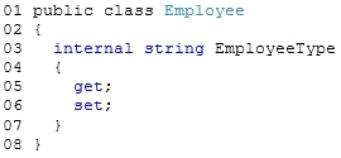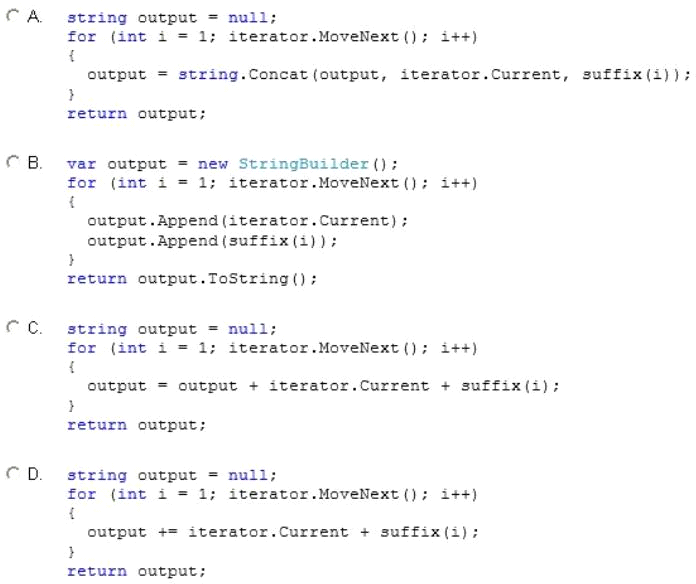Microsoft 70-483 Exam Questions
- Microsoft Certified Professional MCP Certifications
- Microsoft Certified Solutions Associate MCSA Certifications
- Microsoft MCSA: Universal Windows Platform Certifications
- Microsoft MCSA: Web Applications Certifications
- Topic 1: Implement Multithreading And Asynchronous Processing
- Topic 2: Manage Multithreading/ Synchronize Resources/ Implement Locking
- Topic 3: Implement Program Flow Iterate Across Collection And Array Items
- Topic 4: Create And Implement Events And Callbacks
- Topic 5: Implement Exception Handling/ SQL Exceptions/ Network Exceptions/ Communication Exceptions
- Topic 6: Create And Implement A Class Hierarchy/ Find, Execute, And Create Types At Runtime By Using Reflection
- Topic 7: Debug Applications And Implement Security/ Validate Application Input/ Manage Assemblies
- Topic 8: Implement Diagnostics In An Application/ Perform I/O Operations/ Query And Manipulate Data And Objects By Using LINQ
- Topic 9: Store Data In And Retrieve Data From Collections/ Serialize And Deserialize Data
Free Microsoft 70-483 Exam Actual Questions
Note: Premium Questions for 70-483 were last updated On 01-01-1970 (see below)
You have an assembly named Assenbly1 that is written in C#. Assembly1 has a method named Hethodl.
You add a new method named Method2 to Assembly1. Hethod2 is a newer version of Methodl and must be used by applications in the future.
You need to ensure that if a developer builds a project that uses Hethodl, the developer is notified that Method1 is deprecated.
What should you do?
You are implementing a method named Calculate that performs conversions between value types and reference types. The following code segment implements the method. (Line numbers are included for reference only.)

You need to ensure that the application does not throw exceptions on invalid conversions.
Which code segment should you insert at line 04?
Explicit cast of object into float, and then another Explicit cast of float into int.
You are creating a class named Employee. The class exposes a string property named EmployeeType. The following code segment defines the Employee class. (Line numbers are included for reference only.)

The EmployeeType property value must be accessed and modified only by code within the Employee class or within a class derived from the Employee class.
You need to ensure that the implementation of the EmployeeType property meets the requirements.
Which two actions should you perform? (Each correct answer represents part of the complete solution. Choose two.)
protected string EmpType { get; private set;}
This is a quite common way to work with properties within base classes.
Incorrect:
Not D: Cannot be used because of the internal keyword on line 03.
You are developing an application by using C#.
The application includes an object that performs a long running process.
You need to ensure that the garbage collector does not release the object's resources until the process completes.
Which garbage collector method should you use?
You are developing an application that will convert data into multiple output formats.
The application includes the following code. (Line numbers are included for reference only.)

You are developing a code segment that will produce tab-delimited output. All output routines implement the following interface:

You need to minimize the completion time of the GetOutput() method.
Which code segment should you insert at line 06?

A String object concatenation operation always creates a new object from the existing string and the new data.
A StringBuilder object maintains a buffer to accommodate the concatenation of new data. New data is appended to the buffer if room is available; otherwise, a new, larger buffer is allocated, data from the original buffer is copied to the new buffer, and the new data is then appended to the new buffer.
The performance of a concatenation operation for a String or StringBuilder object depends on the frequency of memory allocations. A String concatenation operation always allocates memory, whereas a StringBuilder concatenation operation allocates memory only if the StringBuilder object buffer is too small to accommodate the new data. Use the String class if you are concatenating a fixed number of String objects. In that case, the compiler may even combine individual concatenation operations into a single operation. Use a StringBuilder object if you are concatenating an arbitrary number of strings; for example, if you're using a loop to concatenate a random number of strings of user input.
http://msdn.microsoft.com/en-us/library/system.text.stringbuilder(v=vs.110).aspx
- Select Question Types you want
- Set your Desired Pass Percentage
- Allocate Time (Hours : Minutes)
- Create Multiple Practice tests with Limited Questions
- Customer Support
Currently there are no comments in this discussion, be the first to comment!